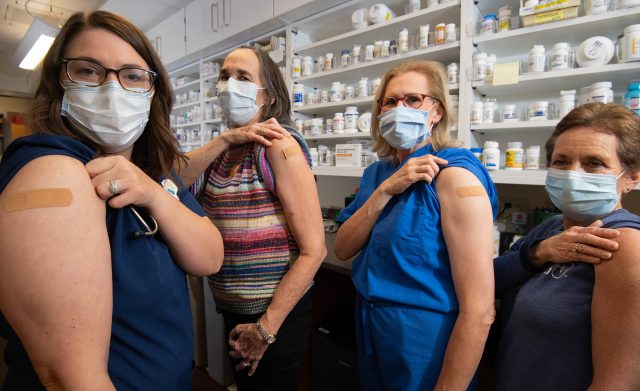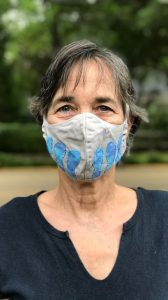My mother married a man who took stairs two at a time, running up. By the time I knew him, my father looked carefully at the height and depth of each stair to determine whether he could raise his leg high enough to reach the top of the stair and whether his shoe would fit on the step with the foot aligned forward, or if he needed to turn his foot sideways to fit.
Same man, changed by the polio virus in 1946.
My family, therefore, clearly understood the potential consequences of viral infections and the benefits of vaccines. One of my earliest memories is from the early 1960s, standing in line outside Watkins Elementary School in north Jackson with hundreds of neighbors, waiting to get my sugar cube polio vaccine.
That was my first encounter with the American public health system. Polio is well-controlled today, through vaccines and public health measures.
I had been waiting and waiting for the COVID-19 vaccine.
When the emergency use authorizations first appeared Dec. 11 for the Pfizer vaccine and Dec. 18 for the Moderna vaccine and doctors began to receive them, I was worried and jealous. When would the vaccine appear in Oxford, and when would I, as a non-hospital-affiliated physician, be able to find one?
One of my siblings sent an email around to the rest of us, asking what we thought about the mRNA technology. He was scheduled to receive the vaccine the following day, but he was a little nervous because the mRNA technology is new for vaccine use. Other siblings weighed in, all voting in favor of the vaccines.
One, an anesthesiologist who has been intubating patients throughout the pandemic, did a deep dive into the COVID-19 literature, the vaccine literature and the polio literature. In addition, he shared with us the type patients he was seeing in the operating suites and ICUs where he works.
He told us precisely how few ICU beds there were and how poor the breathing reserve was in a COVID-19 patient he had seen the day before. He told us his own estimated risk of death from COVID-19 far exceeded any potential risk of a side effect (treatable) from the COVID-19 vaccine.
Another sib, an orthopedist, described the fear he felt every time he operated for fractures in patients who had COVID pneumonia, and how the fear escalated when the operating room doors were sealed with him on the inside with the patient with COVID-19.
On Dec. 30, roughly two weeks after the first vaccines were given outside of trials in the U.S., there was an email from my boss, saying that the Mississippi State Department of Health was offering drive-through vaccines in the county health departments. Immediately, I signed up for a vaccine on Friday, Jan. 8, the first day the vaccine would be available in Lafayette County.
My husband and I rejoiced.
Through Twitter, I heard Jan. 5 that the vaccines would be offered to those above age 75 starting on Jan. 6. My husband and I went online, as he is over 75, and we wanted him vaccinated. Slots were open in Batesville on the 15th, and I urged him to take one. “Nope,” he said. “Greenville, tomorrow. I’m retired. I have time. I can drive to Greenville. Why not?”
The night before his vaccine, we slept poorly. He drove to Greenville, leaving at 10:30 for his 2:20 appointment. He filmed as much of the procedure as he could on his cellphone, so that I could see exactly what the experience was like.
Everything was precisely coordinated and beautifully organized. He and everyone he spoke with wore masks. He never left his car. He was finished by 2:40, and was home again just about 5 p.m., tired but happy.
His arm was a little stiff Wednesday night, but minimally so. We slept well.
Thursday night, before my vaccine on Friday, I again slept poorly. All sorts of thoughts flew through my head: I would have an emergency at the office and miss my time slot; I would get there in time but they would run out of vaccines before they got to me; I would develop symptoms of COVID-19 during the morning before my noon appointment. None of this happened.
I showed my driver’s license, I filled out the requisite paperwork – take a pen with you – and I was passed skillfully from one National Guard person to the next, till finally, I opened my door and pulled up my sleeve to get the shot. I waited in line in my car for 15 minutes after the shot to be observed for any side effects, then I was done.
The whole experience took 22 minutes.
Some 48 hours later, my arm was a little sore, but I had had no fever or achiness. The arm felt like it feels after a flu shot or a tetanus shot, just sore enough to remind me that I have done a good thing. I realize how lucky I am to have been near the front of the vaccine line.
Some things to know about the COVID-19 vaccine
- The vaccine cannot cause COVID-19. It does not contain the live SARS-CoV-2 virus that causes COVID-19, and so it cannot give anyone the illness. It might cause flu-like achiness or headache or fever or other side effects that represent the body building immunity. The side effects go away in a few days.
- Scientists, vaccine developers, physicians and public health officials think the vaccine is as safe as it could possibly be. People who receive the vaccine are monitored for 15 minutes after receiving it – in case of an immediate allergic reaction – and people who have a history of severe allergic reactions are monitored longer. Anyone who has a possible side effect is encouraged to report it to the Vaccine Adverse Event Reporting System, and health care providers also report adverse events to this system. As well, the CDC set up a smartphone-based tool called v-safe, which sends regular text messages to people who enroll, telling them where they can report any problems or worries.
- The Moderna trial enrolled approximately 30,000 participants ages 18-95 in a double-blind, placebo-controlled trial. This means that 15,000 received the vaccine and 15,000 received a placebo. Ten hospitalizations due to COVID-19 were documented, nine in the placebo group and one in the vaccinated group. The median follow-up was two months after the second dose was given, and no specific safety concerns were seen.
- The Pfizer trial enrolled more than 43,000 people in a randomized, double-blind, placebo-controlled trial, which means that 21,500 people received the vaccine. Analysis of the data at two months after the second shot showed no specific safety concerns. Serious adverse events occurred in a similar proportion of vaccine (0.6%) and placebo (0.5%) recipients and at a frequency similar to that seen in the general population.
- The vaccines are effective at preventing symptomatic laboratory-confirmed COVID-19 among persons without previous SARS-CoV-2 infection, with Pfizer reporting 95% effectiveness and Moderna 94.1% effectiveness. High efficacy was observed across sex, race, age and ethnicity categories, and among people with underlying medical conditions, with Moderna reporting at least 86% efficacy in each category and Pfizer at least 92% efficacy in each category.
- The vaccines are felt to be equivalent by the CDC. Take the vaccine you can get, and be sure that your second dose is made by the same company as your first dose.
- Both these vaccines use messenger RNA technology. Each contains material from the SARS-CoV-2 virus, messenger RNA, which travels and gives instructions to our human cells, telling the cells to make spike protein, the spikes we see in images of the SARS-CoV-2 virus. The messenger RNA then is destroyed by the cell. The spike protein is displayed on the surface of the cell that just made it. The body’s immune system recognizes the spike protein as being foreign to the human body and makes antibodies against it. Other parts of the immune system are also activated against the spike protein, such as T lymphocytes called memory cells. The vaccines “immunize” a person in this way, so that if the body then sees the spike protein on a live SARS-CoV-2 virus, it already has a supply of memory cells and antibodies ready to fight the virus immediately.
- The messenger RNA never enters the nucleus of any cell, so it never interacts with or alters the human DNA.
- The messenger RNA vaccines are a new approach to vaccines. Typically, other vaccines have used dead or inactivated viruses, or weakened, live viruses. Researchers have been studying mRNA vaccines for decades, for flu, Zika, rabies and cytomegalovirus. Cancer research has used mRNA technology to teach the immune system to target specific cancer cells. So, though this is a new type of vaccine, the technology has been studied and used in the laboratory for years.
When and how can you expect to get the vaccine?
The state seems to be moving quickly through its phases, so I encourage you to sign up for health alerts from MSDH and Dr. Thomas Dobbs on Twitter. You can also watch the Mississippi State Department of Health website, checking it frequently to see if your group has become eligible to receive the vaccine. We also will be updating the university’s vaccine page.
If your group is eligible, sign up for an appointment as fast as you can type or as fast as you can dial the appointment lines, 877-978-6453 or 601-965-4071. If you are able to drive to another county to get the vaccine, that might get you a shot a little faster.
Besides the drive-through sites run by the MSDH and the National Guard, several clinics have the vaccine.
The University of Mississippi plans to give the vaccine as well. As soon as the university receives its supply of vaccines, we’ll publicize that fact widely. And then we won’t have to be wishing and hoping and waiting any longer.
Dr. Jean G. Gispen is a staff physician at the employee health center within University Health Services at the University of Mississippi.

